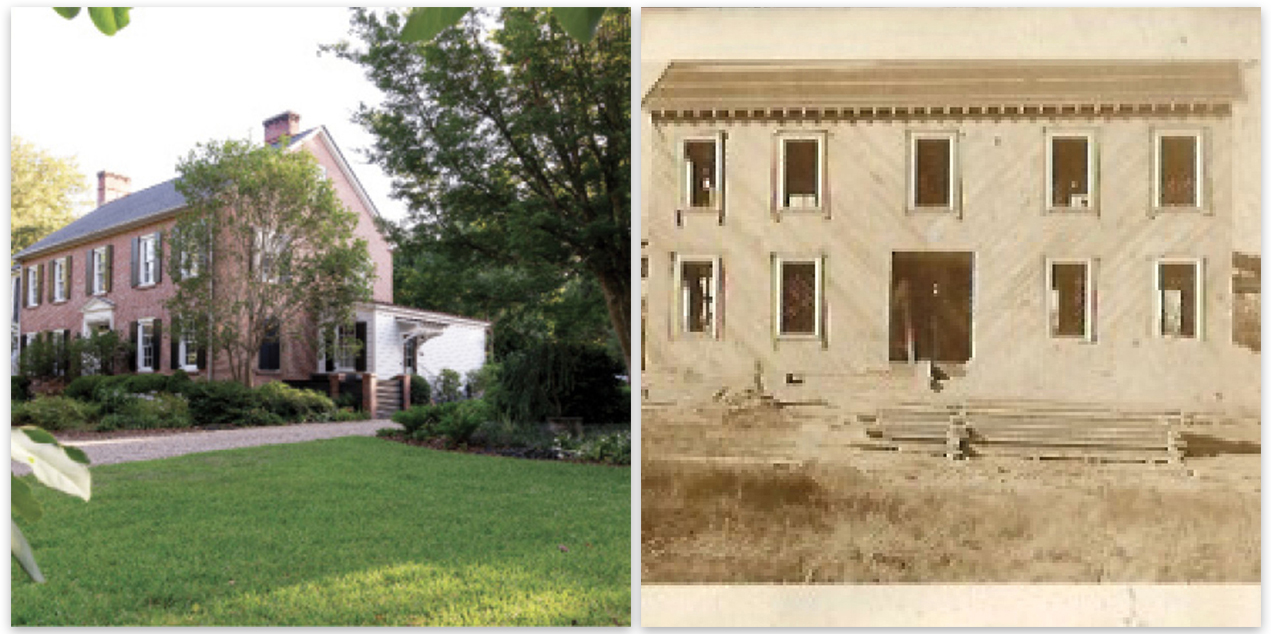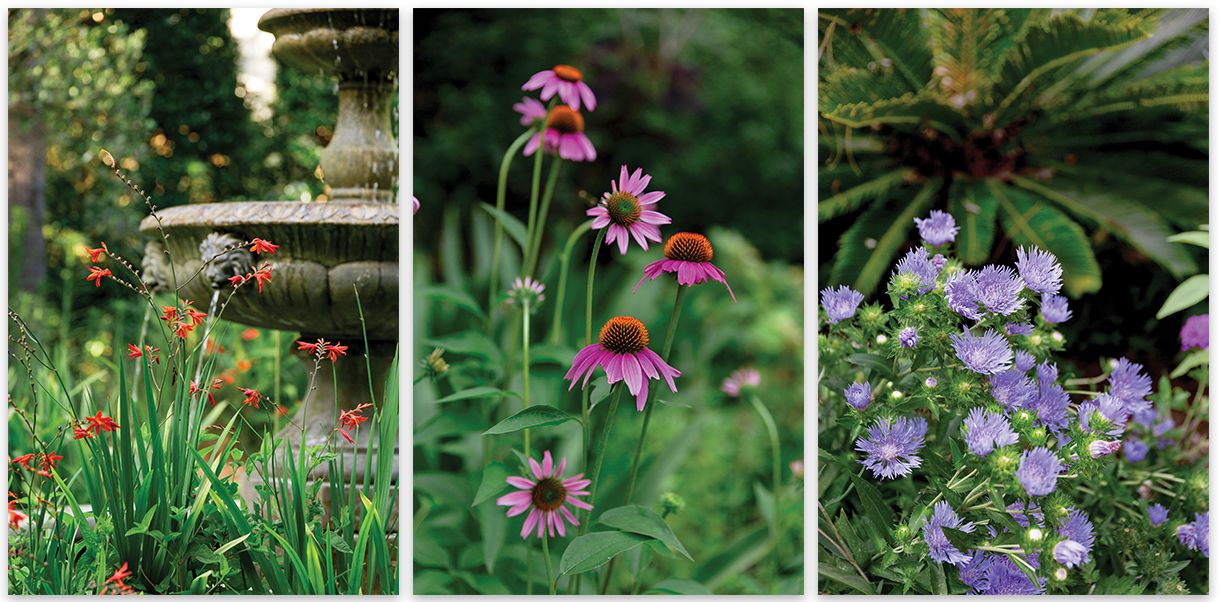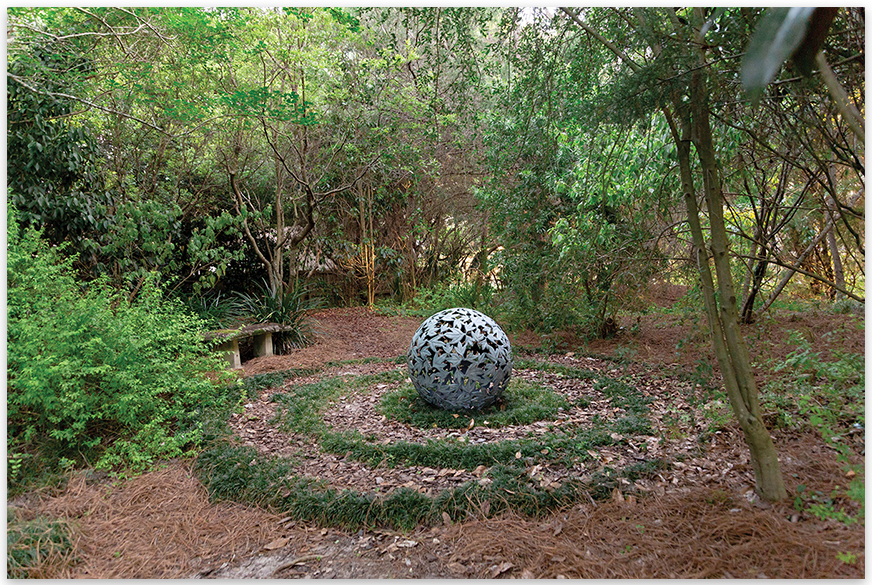Tour meandering paths and verdant garden rooms, then learn about sustainable methods to implement at home

“We’re back here!” calls Susan McLeod Epstein from somewhere in the depths of her West Ashley garden. Crunching footsteps draw closer, and she appears between a pair of cone-shaped hollies that mark a dramatic passage from front yard to back. Unexpectedly, the “we” includes longtime garden designer Beverly Rivers and landscape designer Derek Wade—three local-gardening-scene luminaries out for a roam on a cool, wet day.
“We meet most Tuesdays to talk about soil,” explains Susan. A professional horticulturist and nurseryman, she spent two decades organizing fundraising tours and events for Historic Charleston Foundation, the Charleston Horticultural Society, and the Preservation Society of Charleston. “This morning, we were supposed to focus on pH, but we ended up discussing a webinar Beverly listened to.” That’s how it goes with these pals: all (mostly) retired, all buzzing with new ideas and questions about the best ways to nourish the environment through their gardens—and encourage others to do so, too.
Susan’s green space is nearly two acres that stretch back from Old Towne Road, with a 1930s home at the center. When she and her husband, David, bought the place three decades ago, it hosted a collection of rare camellias, a smattering of trees, and a thick forest of bamboo. Today, it’s a haven where blooming garden rooms string together to form elegant vistas. Yet it also treats visitors to whimsical surprises: a secret cedar pathway; a labyrinth atop a hill; and soon, a sea serpent brought to life from boxwood.

Through the Years: The Epsteins’ home was built in 1934 on former strawberry fields along Old Towne Road in West Ashley. Susan and David purchased it in 1994 and have since added a pool, lush garden rooms, and inviting pathways to the nearly two-acre property. >>See a map of the Epstein Garden here
“My garden is always evolving,” Susan says. In recent years, that evolution has been driven by her discovery of regenerative gardening methods, which focus on building healthy soil. “There’s a whole world beneath our feet—a network made up of soil microbes and roots that has a big impact on the larger ecosystem,” she explains. “We need to cultivate that world and stop killing it with chemicals.”
Laying the Groundwork
Susan had big dreams for this property from the start. Having earned her degree in horticulture from Clemson University, she couldn’t wait to begin transforming the large lot for her family, including David and children Robert and Becca (then eight and 12).
First, they had to rid the place of bamboo. “It was an enormous undertaking,” says Susan. “David estimates that we ripped out about 42,000 stalks in two years.”
By 1996, they were ready to hire landscape architect Thomas Angell of Verdant Enterprises. In front, they wanted to add plantings that would screen sights and sounds from busy Old Towne Road. “We planted all natives—dahoon and yaupon hollies, magnolia trees, and wax myrtles—on both sides of the fence that runs along the street,” Susan notes.
In back, the first priority was a pool. Angell helped them site it just off the newly completed back porch. “We knew we’d later expand the kitchen out onto that porch space, adding a wall of windows, so it was important to create a great view,” Susan explains. “I want to feel like I’m living in the garden, even when I’m not outside.”
Angell worked with Susan to design boxwood parterres in a butterfly shape to link the house to the pool. David, a contractor, used bricks from a pile found on the property to lay an expansive patio for dining and entertaining. A trio of ‘Little Gem’ magnolias went in on the pool’s far side to give this retreat a sense of enclosure from the lawn beyond.
Susan had an idea for the dirt that was excavated in the making of the pool. “I wanted a hill, just for a bit of elevation change,” she says. Toward a back corner of the property, Angell designed a mound some 40 feet across and six feet high, with a swale at the center to collect excess rainwater. It would take Susan years to decide how to fully landscape this feature, but today it’s central to the garden’s magic.
During these early years, Susan planted more trees and shrubs throughout her landscape, creating the foundation for her present-day garden rooms. One of the biggest projects was a three-foot-tall boxwood allée, a pathway of nearly two dozen shrubs that leads along one edge of the front yard, passing an heirloom collection of camellias planted by the home’s second owners. “Bro Schirmer’s father was a hybridizer, and we have some real gems,” Susan says.
Aside from the seasonal flushes of camellia, azalea, and magnolia blooms, the palette was mostly a monochromatic green. “I didn’t know much about which perennials would work in our climate and didn’t want to waste time and energy on annuals,” Susan explains. That would change soon enough.

Guilding Views: A curving bed with liriope, irises, bletilla, hydrangeas, and boxwood—all punctuated by a young longleaf pine—leads to a dramatic holly-tree threshold. A fountain splashes in the intimate garden room beyond, drawing visitors through to the backyard.
Feathering an Empty Nest
In 2000, Susan’s daughter left for college, and she expanded her horizons as well, taking a job coordinating events for Historic Charleston Foundation. Her role gave her entrée into some of the most beautiful private green spaces on the peninsula, including the diverse landscape of renowned home gardener Patti McGee. “I would often stop by to study her plants and their growing conditions,” recalls Susan.
She’d discovered a new world of plant possibilities, and it cracked wide open when the Charleston Horticultural Society brought her on in 2008, first to expand their tours program and then to manage their huge annual sale, Plantasia. “Tasked with going to trade shows and buying thousands of plants, I started getting much more in tune with all the cultivars available,” she says.
Invigorated, she painted her garden with colorful perennials and eliminated areas of lawn to make way for a greater variety of plantings. For example, she carved out a large bed behind the pool room’s ‘Little Gem’ magnolias, filling it with pollinator plants such as hibiscus, crinum lilies, salvia, and echinacea.
Meanwhile, son Robert had also flown the nest, and Susan and David were using their newfound freedom to travel. “Touring gardens in Europe got me excited, thinking, ‘I have a lot of space: I can do some really cool stuff!’” she says.

(Left to right) Crocosmia blooms around the fountain amid daylilies and liriope; Susan has focused on adding more natives to her garden in recent years, including purple coneflowers—beloved by bees, butterflies, and songbirds; Stokes aster is a favorite native perennial.
For an appealing destination at the back corner of the property, her garden-designer friend David Stickel created a “Cedar Walk”—a tunnel of ‘Brodie’ Eastern red cedars that leads to the top of the hill. Here at the highest point, Susan would later use mondo grass to create an eight-foot-wide labyrinth. The spiraling shape is modeled after a nautilus—the marine mollusk whose many-chambered shell has been associated with the growth of wisdom through a person’s lifetime.
“I planted the nautilus in 2015, the year my twin grandsons were born,” says Susan. “I was thinking mostly about a game called ‘snail’ that I liked as a child. It’s similar to hopscotch, and I pictured the boys playing here.”
Now seven, those grandchildren come to splash in the pool, pick flowers for their teachers, and race their bikes through the Cedar Walk. But in the family’s imagination, the nautilus has been elevated beyond play space. “We talk about him like he’s a person—a spiritual, all-knowing being up there,” says Susan.
When it comes to growing personal wisdom, Susan feels she’s made her own progress in recent years. She began learning more about regenerative gardening in 2019 and promptly made changes to her horticultural habits. “I was gardening probably 98 percent organically up to that point,” she notes. “But I was still relying on preemergent for my lawn and pulling out the Roundup for really invasive weeds.”
She cut out all the chemicals and turned to “living mulches”—ground covers like ajuga, selaginella, and mondo grass—for weed control. “They crowd out the unwanted plants, and their roots are good for the soil,” she explains.

5 Steps Toward a Regenerative Garden >>Read more here
Susan also embraced the mantra “Leave the leaves.” When fall came, “I used to try to clean up every leaf in the garden,” she says. “But think about one leaf on top of another—what a perfect habitat for a beneficial insect!” She began allowing more of this nutritious mulch to stay beneath the trees where it fell, topping it with fresh pine straw in places where she wanted a cleaner look. “I try to keep the garden areas near the house tidy-looking, but I let the ones further away get a bit wild and woolly because natural debris—from fallen limbs to dead plant stems—are great for nurturing our wildlife and, ultimately, our soil,” she says.
Her tip for giving your landscape polish, even while embracing an all-natural approach? “Edges, edges, edges!” she says. “I want all my beds to be defined. Even if a bed doesn’t look neat beyond that edge, at least the line shows that I’m intentional.”
Though Susan retired from the Preservation Society last year, there’s no way she can tend all those lines on her own, so she depends on a weekly “mow-and-blow” service. Biannual visits from Tony Hernandez of TH Landscaping are vital to keeping her trees and shrubs shapely. And for creative flair, she works with Virginia-based specialty pruner Trevor Curtis. “This summer, he’s going to begin turning a 20-foot-long boxwood hedge by the driveway into a sea serpent—just for fun!” she says. “I love to have creatures in the garden. I think they make a space come alive.”
More creatures big, small, and absolutely microscopic are arriving in this vibrant garden by the day. And together with her horticulturist pals, Susan is determined to keep the parade coming—into her own landscape and into others’ green spaces, too.
EXPLORE MORE: Watch a video below of Horticulturist Susan McLeod Epstein’s West Ashley Home